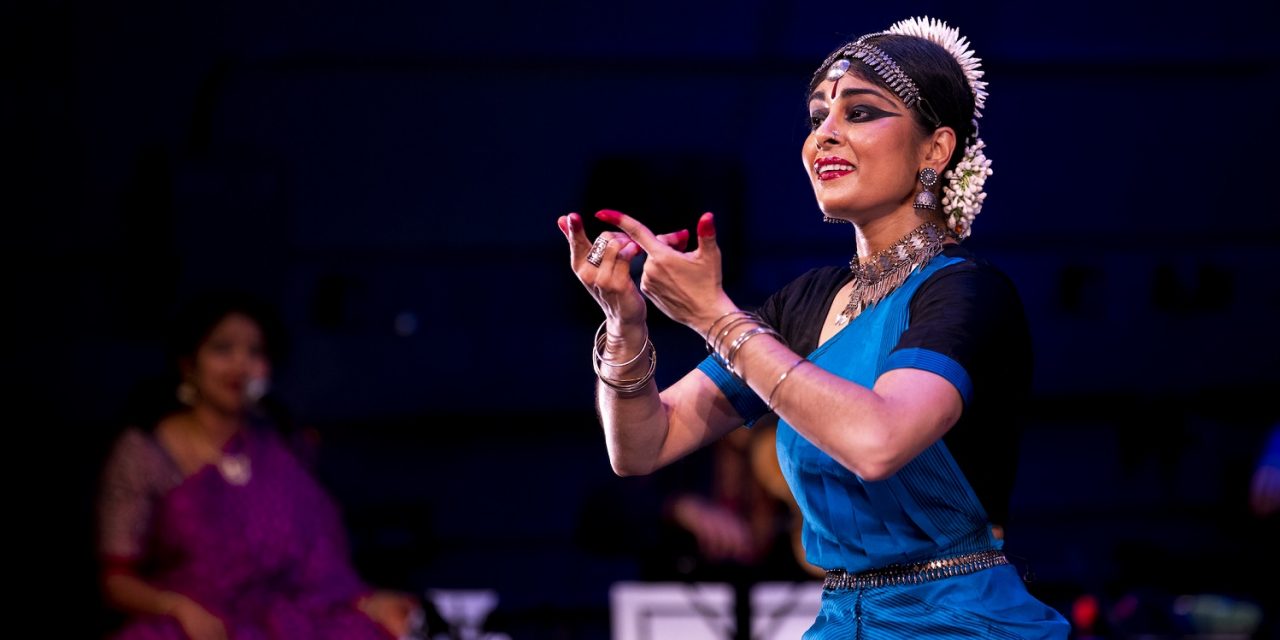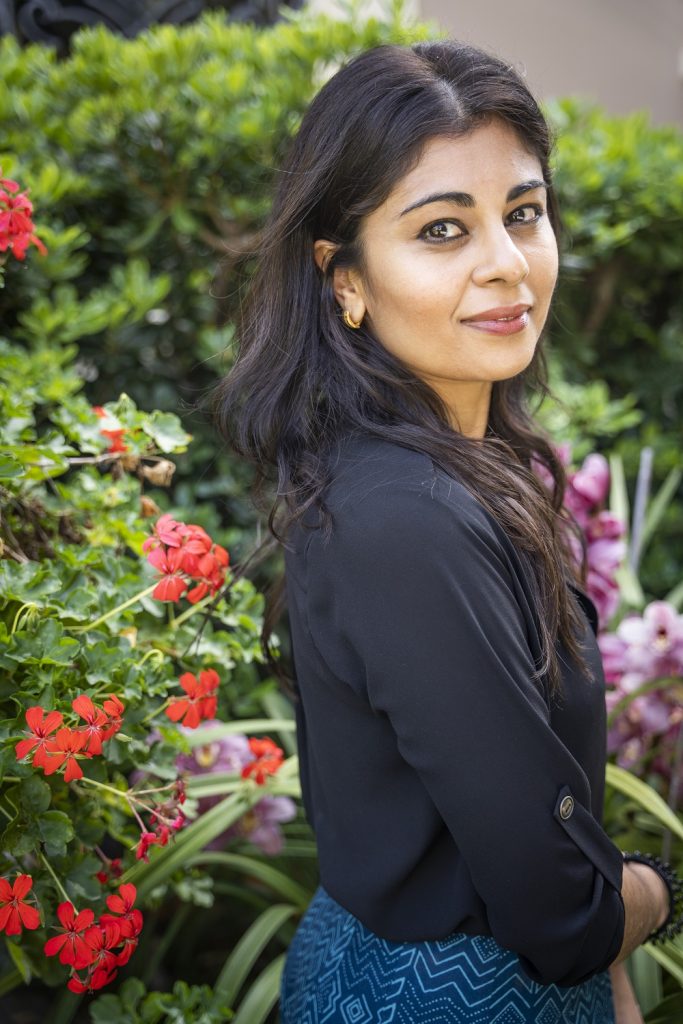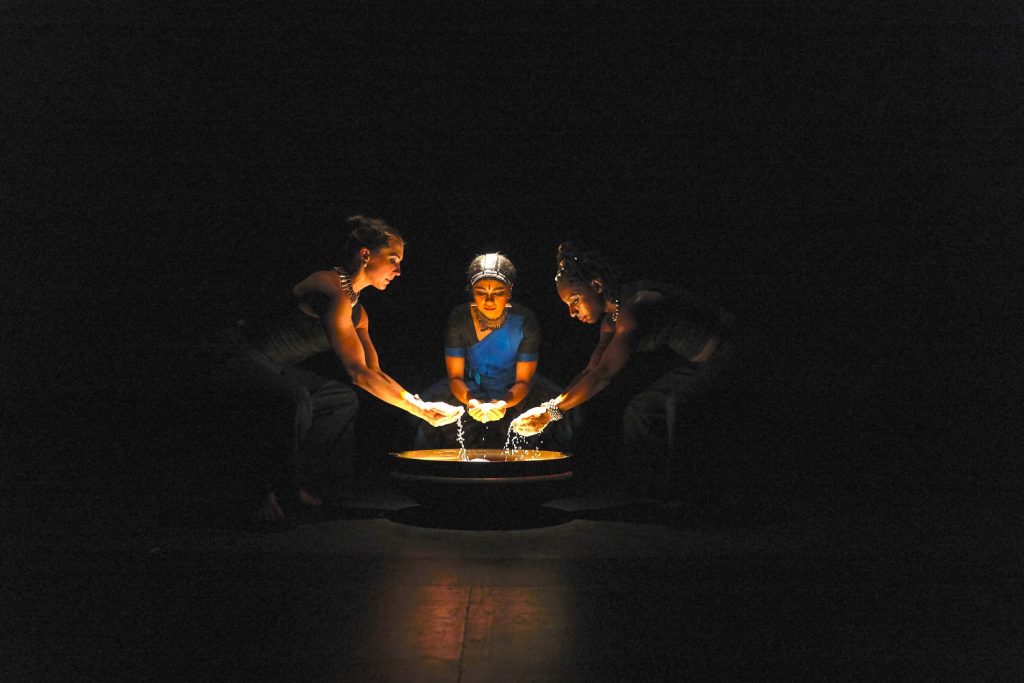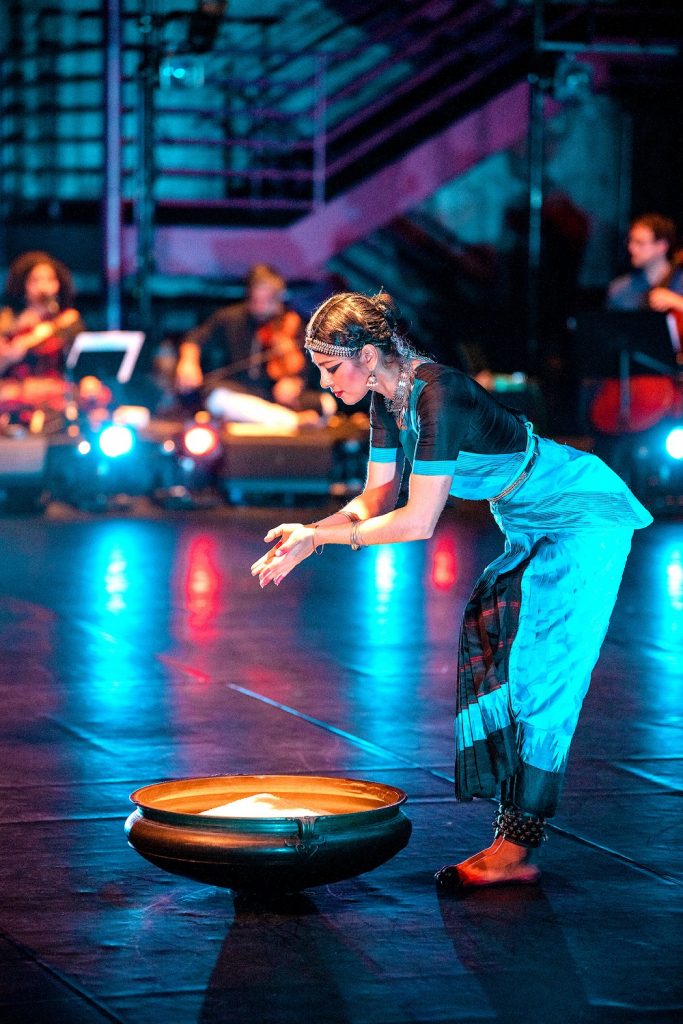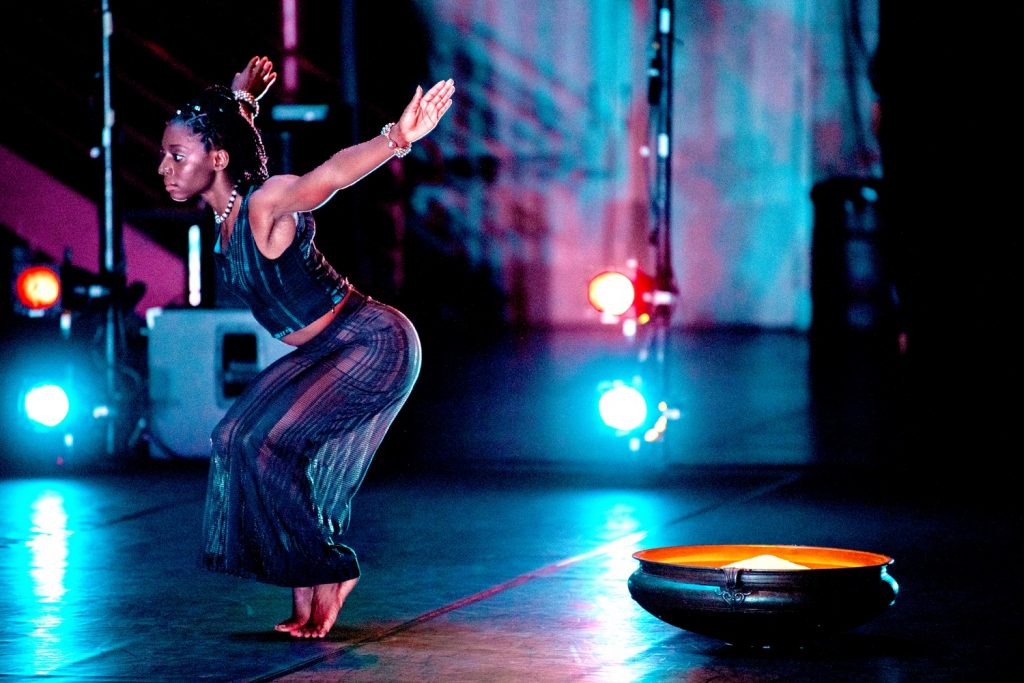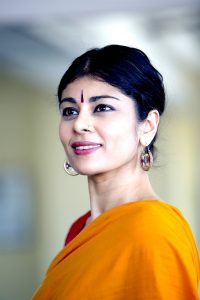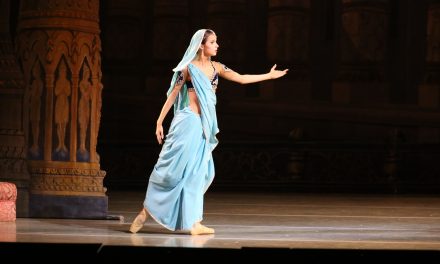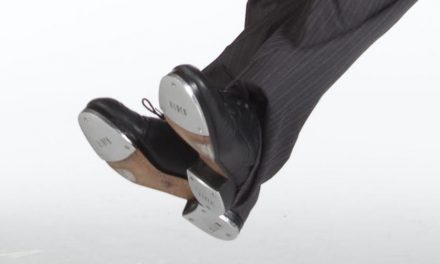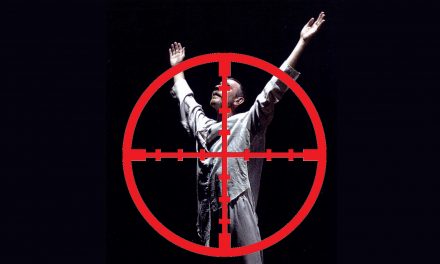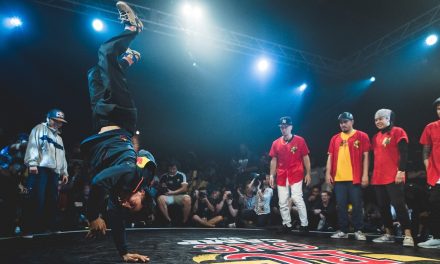Choreographer Ashwini Ramaswamy has brought together the ancient Indian dance form Bharatanatyam, Afro-Modern, and Gaga technique which originated in Israel to create Let the Crows Come. On April 7 & 8, 2023 at 7:30 PM, the much acclaimed work joins a long list of dance performances to grace the Eli and Edythe Broad Stage. This 60-minute work for three dancers with live music by Jace Clayton and Brent Arnold and others, Let the Crows Come, is described as inducing mythography and ancestry with crows acting as metaphoric messengers “for the living and guides for the departed.” BroadStage also offers programs featuring music of all genres and several community outreach programs. Tickets for Let the Crows Come start at $40 and are available HERE or by calling 310.434.3200.
The artists featured in Let the Crows Come are Ashwini Ramaswamy (Bharatanatyam technique), Alanna Morris (Afro-Modern technique), and Berit Ahlgren (Gaga technique). I was able to connect with Ramaswamy on Zoom to learn more about her and this incredible work that has received such glowing reviews around the country, and the Minneapolis Star Tribune listed as one of the 10 Best Performances of 2019.
Ashwini Ramaswamy began her professional dance career as a founding member of the Minneapolis based Ragamala Dance Company which was founded in 1992 by her mother Ranee Ramaswamy and is now led by the mother and daughters team Ranee Ramaswamy and Aparna Ramaswamy, Artistic Directors, and Choreographic Associate Ashwini Ramaswamy. The family run company has toured extensively throughout the United States and abroad including India and were last seen in the Los Angeles area in 2022 performing Fires of Varanasi: Dance of the Eternal Pilgrim to a sold out Soraya Theatre in Northridge. To see a trailer of Ragamala Dance Company, click HERE.
“As an artist of the diaspora, I am a cultural carrier with an instinct to move within ancestral patterns,” explains Ramaswamy. “There is a continuum between what we perceive as real/tangible and what we accept as unknown/unknowable; this gravitation between the human, the natural, and the metaphysical-which are forever engaged in sacred movement-is a focal point in my work.” Minneapolis Broadway World article by Chloe Rabinowitz Oct. 29, 2021
Bharatanatyam is presumably the oldest classical dance heritage of India and is considered the mother of many other classical dance forms. It is one of eight Indian classical dance forms recognized by the Sangeet Natak Akademi. Originating in the Hindu temples of Tamil Nadu, Bharatanatyam is primarily a solo dance performed by women which expresses South Indian religious themes and spiritual ideas. Ramaswamy said that she studied Bharatanatyam with her mother and sister who trained for many years with the renowned dancer/choreographer Alarmél Valli in Chennai, India. I asked her if she had studied other forms of dance. (You can watch a You Tube video of Valli HERE.)
“No, everything is strictly Bharatanatyam performed, practiced and choreographed on myself,” she said. “But the experimentation comes from the conversations with other dance forms.”As she had done several times before in other cities, Ramaswamy will be setting a new work on students at Santa Monica College that will not be strictly a Bharatanatyam piece but will be based on the principles of that dance form. “We will work with the strengths of the dancers and come up with something that works for us all,” she added.
When asked to explain the genesis of Let the Crows Come, Ramaswamy said that there were different threads of how it all came together for her.
“The first thing that happened was I read an article about crows,” she related. “It talked about them in a way that I had not thought of before as creatures who are very family oriented. They mate for life. They recognize human faces. They can make rudimentary tools to do certain things. They are very smart and I had always thought of them as bad omens or scavengers. I was very intrigued and as a side note, that you can’t assume that anything is what it seems.”
Another interest that Ramaswamy was thinking about was collaborating with a DJ who was also a composer. She wanted to find someone who could create a soundscape that remixes elements of music that she was used to working with to create sonically what it feels like to be bicultural or multicultural.
“Even within one day you have to code switch or feel like you’re in a different place and communicating in a different way, especially as artists, you know, we vocalize the immigrant experience. We’re talking to different people at all times and explaining in different ways.”
Also during this time Ramaswamy had a meeting with artistic director, producer and owner of Liquid Music, Kate Nordstrom. Nordstrom has a program called Liquid Music Series that helps bring together people who might not find opportunities to collaborate. Through this program Ramaswamy was introduced to composer Jace Clayton aka DJ/rupture, a New York-based American DJ, writer and interdisciplinary artist. Clayton is not a club DJ, but a composer who for years has been sampling world music. Another composer that she is working with is electronic cellist, Brent Arnold.
The extraordinary music artists who add further richness to Let the Crows Come are Roopa Mahadevan (vocals), Arun Ramamurthy (violin), and Rohan Krishnamurthy (south Indian percussion).
While thinking about a theme for her collaboration with Clayton, Ramaswamy realized that there is a period in Hinduism called Pitru Paksha that lasts for a two week period after someone passes. One of the rituals during that time involves the family of the deceased putting out cooked rice for the crows.
“When and if the crows come and eat the rice” she explained, “they’re seen as messengers between worlds. It is a message from your departed ancestor or relative that they have ascended to where they are supposed to be and that you should continue on with your life. In Hinduism, death is not the end. It is a new beginning. I loved this idea of crows being so much more than what we think and that it has this connection to the Hindu culture that is so important to my work. So, the theme emerged of let the crows come, the crows being something to welcome.”
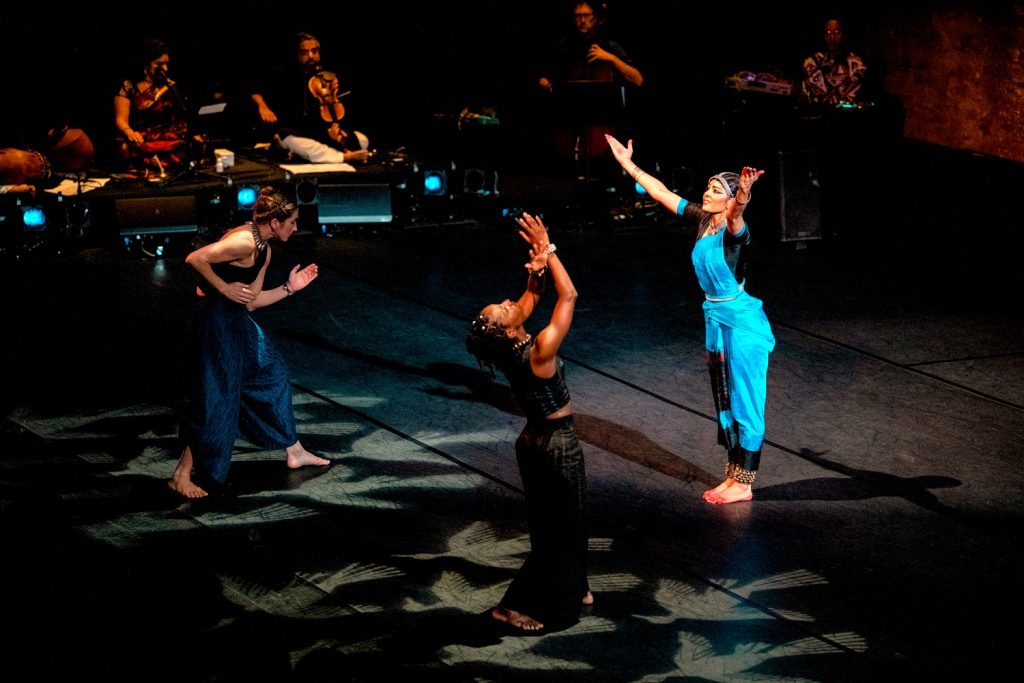
“Let the Crows Come” – (L-R) Berit Ahlgren, Alanna Morris, Ashwini Ramaswamy (choreographer) – Photo by Jayme Halbritter
My next question was directed to how Ramaswamy chose the two dancers, Alanna Morris and Berit Ahlgren, to work with on this project.
“In the development of the concept, I knew that when I presented the work, when I was dancing, I wanted it to be Bharatanatyam in my lineage with nothing altered,” she began. “It’s new choreography but in the style of what I have trained in for decades.”
Ramaswamy knew that she wanted to begin with her performing a solo with classical South Indian instruments to make certain that the audience first saw the form as she intended and as intended to be presented by her teachers and her lineage. She then wanted to show the influences on her life that she has experienced during her travels and performing around the U.S. and the world. She knew too, that she had long been intrigued with the form of dance called Gaga and wanted it to be represented in the work. She approached Berit Ahlgren, who she knew had studied the Gaga Movement Technique with Batsheva while living and working in Tel Aviv, who agreed to work with her. Ahlgren is also an independent performer and choreographer in her own right and is on the faculty at the University of Minnesota and Winona State University.
The third dancer in Let the Crows Come is Alanna Morris, who has performed leading roles in works by Kyle Abraham, Gioconda Barbuto, Camille A. Brown, Ronald K. Brown, Gregory Dolbashian, Katrin Hall, Francesca Harper, Dwight Rhoden, and Uri Sands.
“I have always admired her. She gives everything on the stage! She’s very commanding. So, it wasn’t just about a style,” Ramaswamy stated, talking with her hands, “I just wanted her energy!”
Ramaswamy explained that because Bharatanatyam is a solo form, that it is a two or three hour period where you have to command the stage. Therefore, she needed to find people who were able to show their own facets of themselves, to be true to themselves but also be highly trained. Bharatanatyam is not written down so it is traditionally passed down from teacher to student.
She used the example of several people being in a room, sharing an experience, going their separate ways and then when asked about this experience, each person will talk about it differently. “So, it is this shared memory that is shared differently from person to person that is behind these echoes.”
The impact of this example is demonstrated in this “Critic’s Pick” from The New York Times: “Even as the dancers matched and echoed one another’s arms and feet, their interpretations were, at times, wildly — and certainly stylistically — different. Yet they were all capable of holding the stage with a similar intensity, as if they were dance spirits, one shadowing the other. And the music was just as important.”
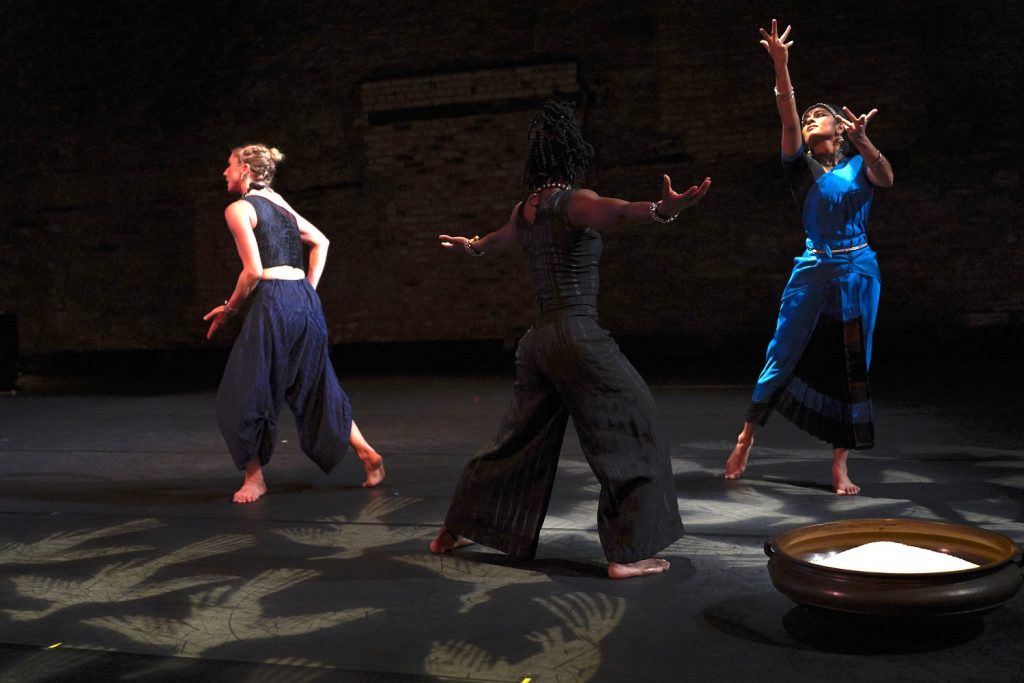
(L-R) Berit Ahlgren, Alanna Morris, Ashwini Ramaswamy in “Let the Crows Come” – Photo by Jake Armour
Ramaswamy worked differently with each dancer. With Ahlgren, she filmed seconds of her solo and then using iMovie, she flipped them backwards and slowed them down. She found out, however, that one of the ways Ahlgren had trained in the Gaga Movement Technique was exactly that – learning movement and then reversing their pathways to open up the muscle memory even more in the mind – so this was not a huge huddle for Ahlgren.
“So when you see her solo compared to mine,” Ramaswamy said, while moving somewhat sporadically, “it almost looks like it’s been reprocessed through a video machine.”
It is the same solo set on three different bodies, but no one does anyone else’s form. “Alana is very expressive” Ramaswamy restated, “and Bharatanatyam is a highly expressive form. We worked on the narrative elements in her face as well as taking the gestures and extrapolating the gestures into full body movement for her. So, there’s the connection that way and nothing looks like a literal interpretation.”
Ramaswamy went on to say that when one sees the work, it will be very clear how collaboratively Let the Crows Come was created, and when I asked if it was a narrative work she explained that it was a layering of narratives.
“What I’ve done is select three poems from the Sangam era of Tamil literature, so this is a pre-religion text that reveres the environment as almost like a God, as a lot of civilization did” She said. The Sangam age extended between 300 BC and 300 AD or thereabouts. According to my research, most of the work is believed to have been composed between 100 CE and 250 CE. Ramaswamy explained that there are five landscapes in these Sangam poems: farmland, forest, mountains, desert, and seaside. “In two of them the image of the crow is seen as a message of hope. In the poem about the seaside, the crow flies up and sees that the fishermen are coming back, so that the village can rejoice, and there’s the sense of nature communing with man and working together.”
There is another very famous poem that all three performers end their solos with that talks about wherever one is in life, whether you are the richest or the poorest person, we all must live harmoniously and treat each other well. “I take that as the advice that the ancestors are telling us to do now,” Ramaswamy stated and added that she hopes that audience members will leave having received that message.
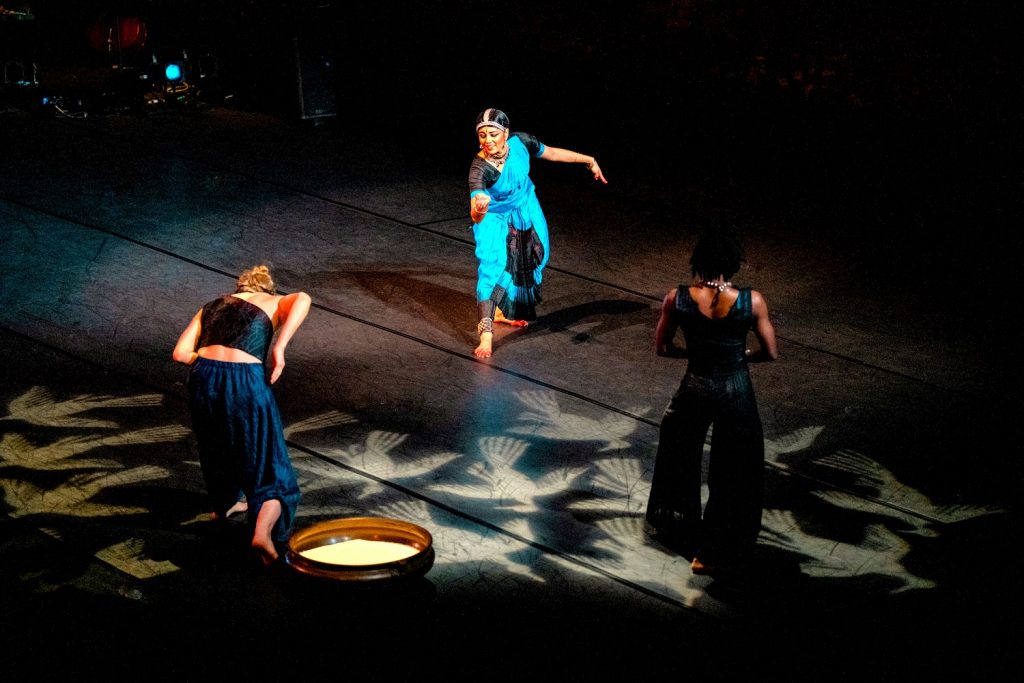
(L-R) Berit Ahlgren, Ashwini Ramasayma, Alanna Morris in “Let the Crows Come” – Photo by Jayme Halbritter
The Sangam poems are sung as part of the work’s soundscape and she said that there is another text that is heard during the trio sections within Let the Crows Come that relates to how in India there is a high belief in astrology in predicting the future. This particular text is highly detailed explaining “ from a blade of grass blowing in a certain direction to the way a raindrop falls off of a flower pedal, it means certain things,” Ramaswamy explained.” The omens predicted by the crows depends on which direction they are flying. Each direction foretells a different future.
In the trio sections, there is a recurring theme during which one soloist depicts an omen while the other two represent the direction or a corresponding element of nature.
We discussed how there are many cultures around the world that use the crow as an omen for either good or evil. “Yes, and because we are seeing it as a messenger from our ancestors, I am taking it as all the centuries of connection coming down,” Ramaswamy said. “Whether it’s my own specific ancestors or the lineage of Bharatanatyam teachers who have gotten me to where I am today.”
Ramaswamy told me that she is extremely grateful to be working with her mother and sister and for their being her mentors. They not only taught her the Bharatanatyam method of dancing but how to research all of these texts and to see things in a way that is very expansive but also intimate in order to guide her in the creation of her own work.
She has known and worked with the Indian composer, Prema Ramamurthy, who recreated the Carnatic score as well as the musicians who will be performing live at BroadStage and who have contributed a great deal to the reworking of the score. Ramaswamy described how Indian music is composed but that like jazz, it is greatly improvised, and performed differently from performance to performance. For this work, however, it was the first time she worked with electronics composer Jace Clayton and Brent Arnold, electronic acoustic cellist. Clayton’s music was used for Berit Ahlgren’s solo and Arnold’s for Alanna Morris’ solo.
Let the Crows Come is very unique in the way it has been conceived and created. It is 60 minutes in length and includes live music! The work was choreographed in 2019 and performed to great critical accolades, but more importantly it has been enthusiastically received and commented on by audiences everywhere.
“The message of inclusivity and community that comes up” Ramaswamy said, “people have really responded to that beautifully. We really give you a personal vision of our personal styles onstage.” And from what I have read the dancing is truly gorgeous as is the music. I hope that people will come out to see this amazing performance.
#####
WHAT: Ashwini Ramaswamy’s Let the Crows Come
WHERE: BroadStage located at 1310 11th St, Santa Monica, CA 90401.
WHEN: April 7 & 8, 2023 at 7:30 PM.
TICKETS begin at $40. For more information and to purchase tickets, please visit BroadStage website or call 310.434.3200.
For more information about Ashwini Ramaswamy, please visit her website.
Also appearing at BroadStage: Belgium based Company Focus & Chaliwaté’s Dimanche (April 13 – 16, 2023). To see BroadStage’s full season line up, please visit their website’s Performances page.
Written by Jeff Slayton for LA Dance Chronicle.
Featured image: Ashwini Ramaswamy – Photo by Maria Baranova

